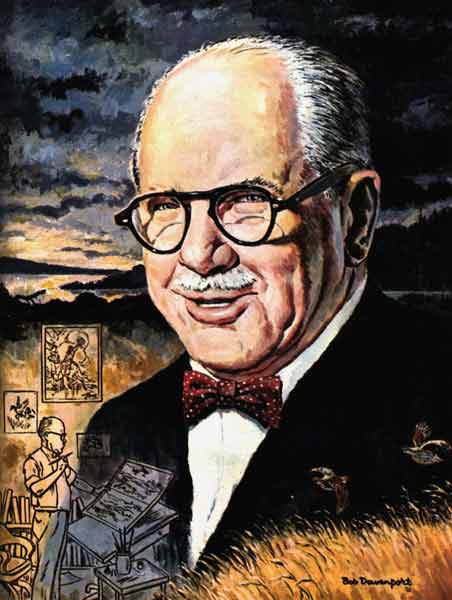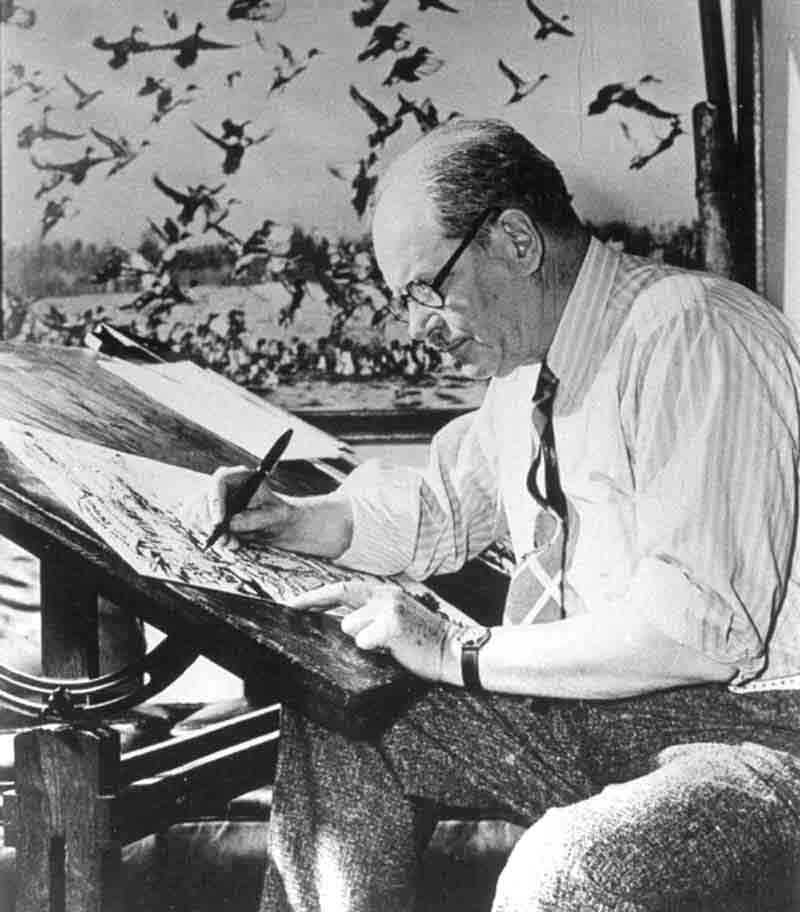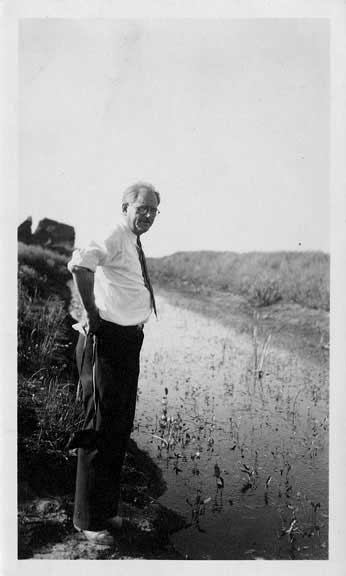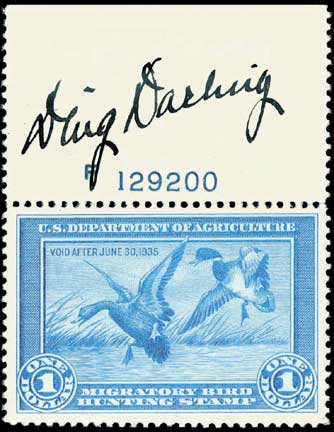Iowa Conservationists: Ding Darling
Posted on June 10, 2016 in Blog
 "Ding" Darling was a Pulitzer Prize-winning cartoonist and an accomplished conservationist from Iowa. As a cartoonist, he worked for the Des Moines Register for nearly half a century and was nationally syndicated. As a conservationist, Darling held key state and federal conservation positions, was the first president of the National Wildlife Federation and the namesake for the "Ding" Darling National Wildlife Refuge in Florida. In 1934, the cartoonist blended his talent with his conservation work to design the first duck stamp.
"Ding" Darling was a Pulitzer Prize-winning cartoonist and an accomplished conservationist from Iowa. As a cartoonist, he worked for the Des Moines Register for nearly half a century and was nationally syndicated. As a conservationist, Darling held key state and federal conservation positions, was the first president of the National Wildlife Federation and the namesake for the "Ding" Darling National Wildlife Refuge in Florida. In 1934, the cartoonist blended his talent with his conservation work to design the first duck stamp.
Darling left a lasting impression on the conservation movement in the 20th Century and beyond. He wanted nothing more than to see the land that he remembered from his youth be protected for future generations. Darling wrote, "If I could put together all the virgin landscapes which I knew in my youth and show what has happened to them in one generation, it would be the best object lesson in conservation that could be printed."
Read on to learn more about Darling, his accomplishments and his legacy.
Ding Darling: The Man
Jay Norwood "Ding" Darling took his middle name from his birthplace of Norwood, Michigan, but considered himself an Iowan. Darling credited his childhood in Sioux City with teaching him lifelong lessons in the conservation of nature's resources. He took his famous nickname from the contraction of his surname--"D'ing."
Darling, one of the most influential Iowans in the 20th century conservation movement, was born October 21, 1876. The Darling family settled in Sioux City when he was 10 years of age.
Ding attended Beloit College in Wisconsin, intent on following an uncle into a medical career. Following his graduation, in an effort to save money for medical school tuition, he worked as a reporter for the Sioux City Journal, where he later began his cartooning career.
While in Sioux City, Ding married one of his former classmates, Genevieve "Penny" Pendleton on October 31st, 1906. Darling became a father in 1909, when his son, John, was born. His second child, Mary, was born in 1912.
With the success of his cartoons at the Journal, he continued his cartooning career at the Des Moines Register and then the New York Globe. After working in New York for a short time, Ding returned "home" to Iowa to work for the Register again. His cartoons were nationally syndicated by the New York Herald Tribune, while he worked for the Register and remained in Iowa. Darling went on to be honored with two Pulitzer Prizes for his cartoons.
Darling was a conservation leader as well as a cartoonist. He retired from the Register in 1949, but his conservation work was done throughout his cartooning career and after.
As a lifelong hunter and outdoorsman, Darling was a dedicated conservationist at state and federal levels. In Iowa, he was one of the original members of Iowa's Fish and Game Commission, where he encouraged the commission to conduct a biological survey of the state. The result was a 25-year conservation plan that became a model for the nation. Also, he used his own funds to create a wildlife research unit to educate Iowa State students about conservation management. Similar units are now in place in 38 states.
Darling's conservation work went beyond Iowa. Franklin D. Roosevelt appointed Darling to a "special Presidential committee." The committee recommended a land and wildlife reclamation program to aid migratory waterfowl. Darling was later appointed by F.D.R. to be the Chief of the Bureau of Biological Survey, the forerunner to the U.S. Fish and Wildlife Service.
In the course of his long and productive life, Darling repeatedly was recognized for his stream of accomplishments. In addition to his Pulitzer Prizes, he received scores of major awards, honorary doctorates, the Audubon Medal, the Roosevelt Medal and the Hutchinson Award.
Ding Darling: The Cartoonist
In an effort to save money for medical school tuition, J.N."Ding" Darling worked as a reporter for the Sioux City Journal after he graduated from Beloit College in Wisconsin.
Early in his work there, he had been ordered to obtain a photograph of a local lawyer involved in a colorful lawsuit, but failed in his mission because the irate barrister, cane in hand, chased him out of the courtroom. Darling, who had sketched since childhood, was able to furnish a drawing of the lawyer he had done earlier to use for publication. His editor liked his sketch and ran Darling's artwork with his article. Darling was soon instructed to draw depictions of Sioux City characters. Thus began a political cartooning career that spanned nearly a half-century.
Darling continued at the Journal as a reporter-cartoonist for six years before papers in Des Moines began to compete for his attention. Following his marriage, Darling took a position at the Des Moines Register.
In 1911, he said goodbye to the state he claimed as his home to work for the New York Globe for a short time. When he officially returned to Iowa to work for the Register again, after living in New York, he suggested, "The people of Iowa think more to the square inch than the people of New York think to the square mile...." The New York Herald Tribune offered to include Darling's cartoons in its syndicated service. Darling took the offer, which required monthly travel to New York while he continued to live and work otherwise in Des Moines.
Darling was awarded two Pulitzer Prizes for cartoons nearly 20 years apart. He won the first of his Pulitzers in 1924 for his cartoon titled, "In Good Old U.S.A." At the time, it was the second Pulitzer to honor a cartoon. Darling was awarded his second Pulitzer Prize in 1942 for a cartoon he did that depicted Washington D.C. in a sea of paperwork called, "What a Place for a Waste Paper Salvage Campaign."
Darling was acclaimed by his peers as the foremost political cartoonist in the United States. After he had moved back to work for the Register, he continued to receive offers from other prestigious newspapers. Joseph Pulitzer himself had asked Darling to join the St. Louis Post-Dispatch staff, but Darling declined.
Darling retired from the Register in 1949. His work with the Des Moines Register and syndication nationwide by the New York Herald Tribune made "Ding" a household name.
Ding Darling: The Conservationist
Iowa efforts
In his home state, Darling was appointed to the first Iowa Fish and Game Commission in 1931. As one of the original members, Darling prodded the commission to conduct an ambitious biological survey of the state. The result was a 25-year state conservation plan that became a model for the nation.
A year into the commission, Darling conceived the Cooperative Wildlife Research Unit Program and launched the first unit for three years at Iowa State College (now Iowa State University) with his own funds. He intended that the program would educate young men and women in various academic disciplines about wise conservation management. The program was created because Darling had noticed there weren't enough scientifically trained people to do professional wildlife research. He intended, also, that the program would be truly a cooperative partnership among the state natural resources agency, the academic institution and eventually, the U.S. Department of Interior and the non-governmental Wildlife Management Institute. Darling extended the Cooperative Wildlife Research Unit concept to other states; there are now 40 such units in 38 states.
Darling believed fervently in the incorporation of conservation principles as part of a liberal education. "Turn the natural resources of any area over to an ecologically ignorant populace and ecologically ignorant leaders, and they will rape the land and waters with as little regard for future consequences as the profit-motive boys display," he said.
Federal efforts
In addition to his Iowa work, Darling was a conservation leader at the federal level. In 1934, President Franklin D. Roosevelt appointed the staunch Republican Darling to the so-called "Beck Committee" to recommend a land and wildlife reclamation program that would help turn the precipitous decline in migratory waterfowl. The committee was chaired by Tom Beck, editor of Collier's magazine, and also Iowa-born scientist and nature writer Aldo Leopold. Darling was appointed because of his conservation knowledge and his work as a member of the Iowa Fish and Game Commission. The committee's report included Darling's devastating critique of the leadership of the U.S. Bureau of Biological Survey, the forerunner to the U.S. Fish and Wildlife Service.
Despite the fact that Darling's political cartoons were consistently critical of FDR, the president appointed him as Chief of the Bureau of Biological Survey later that year. As Chief, Darling turned the agency on its head. He gave greater freedom to the capable scientists on board and attracted to the Bureau a platoon of young, energetic scientists and managers, some of whom devoted the remainder of their working lives to protection of the nation's natural treasures. Meanwhile he reserved three million acres of public land for wildlife refuges.
Darling was the architect of the greatly expanded system of National Wildlife Refuges. Some consider Darling's expansion of the wildlife refuges, combined with the generation of public support for the protection of threatened habitat, his greatest legacy.
Darling stepped on many toes, including those of FDR, in his brief but effective tenure as Chief of the Biological Survey. In 1935, after approximately 18 months at the helm, he submitted his resignation. His departure was mourned on editorial pages from New York to Los Angeles.
The First Duck Stamp
During his time in Washington, Darling lobbied incessantly for the passage of the Migratory Bird Hunting Stamp Act, and he designed the first duck stamp in the popular "Duck Stamp" series. Since their introduction in 1934, sales of Duck Stamps have raised hundreds of millions of dollars for the purchase of approximately five million acres of waterfowl habitat. (By Darling's design, approximately 98 percent of all proceeds from Duck Stamp sales are invested in habitat.) A postal commemorative stamp issued in 1984, bearing the original Duck Stamp design, sold nearly 124 million copies. Combined with the 635,000 original Duck Stamps, the design is one of the most reproduced and widely-recognized examples of wildlife art in the world. As the first duck stamp and a well-known example of Darling's work, the stamp has become a collector's item for outdoors enthusiasts.
Private efforts
Darling returned to Des Moines after his term and began, almost immediately, to organize a national consortium of conservation organizations to fight what he had seen were the well-organized Washington, D.C., pressure groups with no interest in conservation. In his colorful fashion, he noted, "eleven million horses running wild couldn't pull a rubber-tired baby buggy to town unless there was a harness to hook them to the load."
The result was the National Wildlife Federation--the largest organization of its kind. Darling was elected its first president in 1936. In 1939, after being re-elected twice, he tendered his resignation because of the health of his son, John, who had been seriously injured in an auto accident.
In his later years, Darling spent a lot of time in Florida with his wife and had a special kinship for Sanibel Island. Darling and others struggled to prevent a causeway from being built between the mainland and the island, but it was constructed anyway. Darling made a long-time personal commitment to protecting the island sanctuary from developers of hotels, condominiums and strip malls. The "Ding" Darling National Wildlife Refuge, on Sanibel Island, was officially renamed in 1978 to honor his devotion to the island. The refuge's 6,354 acres, of which over 2,000 acres are designated wildlife area, provides a home for over 200 species of birds, some of which are threatened or endangered.
Ding continued to dedicate himself to conservation into his later years. "I'm learning one thing the hard way, and that is that you have to re-educate the public mind every fifteen or twenty years or it forgets everything learned a while back," Darling explained his dedication.
Darling and INHF
After Darling's death in 1962, the J.N. "Ding" Darling Foundation was created to continue some of his favorite projects. For forty years the foundation provided annual Ding Darling scholarships for wildlife students at Iowa State University.
In 2005-06, as the Darling Foundation planned to dissolve, they helped establish a Ding Darling Conservation Education Fund at INHF to keep the Darling name and spirit alive in Iowa through education activities.
The INHF Ding Darling Conservation Education Fund supports:
- Ding Darling Scholarships for Iowa State University students who are studying the natural world and/or communications.
- A variety of educational projects in tribute to Ding Darling.
The Fund also helped us expand the number of college interns who gain land stewardship experience with the INHF staff.
The Ding Darling Conservation Education Fund also allowed INHF to be a financial sponsor of “America’s Darling,” a documentary film that will help keep Ding’s conservation voice alive as inspiration for today’s Iowans.
In 2015, the Brush of Excellence award was established as a way to honor dedicated conservation leaders in Iowa. The framed paintbrush that compromises the award was originally owned and used by Darling.
Resources
If you want to learn more about the life, cartoons and influence of Ding Darling, consider checking out the links and publications below.
J.N. "Ding" Darling Foundation
More Duck Stamp information
Friends of the Migratory Bird/Duck Stamp
The Ding Darling National Wildlife Refuge (Florida)
The Ding Darling Wildlife Society
More Ding Darling cartoons